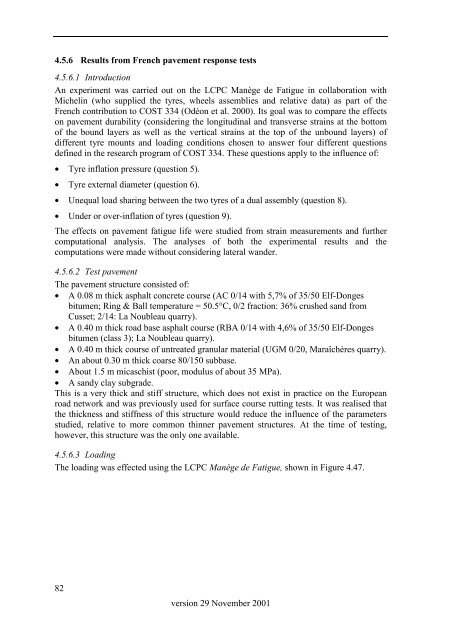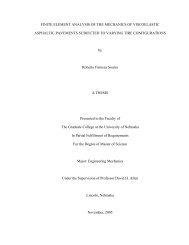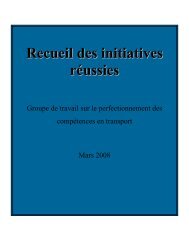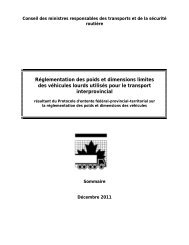You also want an ePaper? Increase the reach of your titles
YUMPU automatically turns print PDFs into web optimized ePapers that Google loves.
4.5.6 Results from French pavement response tests4.5.6.1 IntroductionAn experiment was carried out on the LCPC Manège de Fatigue in collaboration withMichelin (who supplied the tyres, wheels assemblies and relative data) as part of theFrench contribution to <strong>COST</strong> <strong>334</strong> (Odéon et al. 2000). Its goal was to compare the effectson pavement durability (considering the longitudinal and transverse strains at the bottomof the bound layers as well as the vertical strains at the top of the unbound layers) ofdifferent tyre mounts and loading conditions chosen to answer four different questionsdefined in the research program of <strong>COST</strong> <strong>334</strong>. These questions apply to the influence of:• Tyre inflation pressure (question 5).• Tyre external diameter (question 6).• Unequal load sharing between the two tyres of a dual assembly (question 8).• Under or over-inflation of tyres (question 9).The effects on pavement fatigue life were studied from strain measurements and furthercomputational analysis. The analyses of both the experimental results and thecomputations were made without considering lateral wander.4.5.6.2 Test pavementThe pavement structure consisted of:• A 0.08 m thick asphalt concrete course (AC 0/14 with 5,7% of 35/50 Elf-Dongesbitumen; Ring & Ball temperature = 50.5°C, 0/2 fraction: 36% crushed sand fromCusset; 2/14: La Noubleau quarry).• A 0.40 m thick road base asphalt course (RBA 0/14 with 4,6% of 35/50 Elf-Dongesbitumen (class 3); La Noubleau quarry).• A 0.40 m thick course of untreated granular material (UGM 0/20, Maraîchères quarry).• An about 0.30 m thick coarse 80/150 subbase.• About 1.5 m micaschist (poor, modulus of about 35 MPa).• A sandy clay subgrade.This is a very thick and stiff structure, which does not exist in practice on the Europeanroad network and was previously used for surface course rutting tests. It was realised thatthe thickness and stiffness of this structure would reduce the influence of the parametersstudied, relative to more common thinner pavement structures. At the time of testing,however, this structure was the only one available.4.5.6.3 LoadingThe loading was effected using the LCPC Manège de Fatigue, shown in Figure 4.47.82version 29 November 2001






